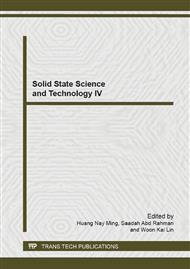p.375
p.385
p.390
p.395
p.400
p.407
p.411
p.415
p.420
Effect of High-Energy Ball Milling on the Charge-Discharge Behaviour of LiCo0.3Ni0.7O2
Abstract:
Li-ion cathode materials in the nanodimension should show improvement in capacity retention from the normal material. This is because the electrochemical performance of the cathode material in lithium secondary batteries depends on the electrochemical redox reaction which is affected by the surface area to volume ratio of the particles. In this work, LiCo0.3Ni0.7O2 powder will be prepared via a self-propagating combustion method and the high-energy ball milling method will be used to prepare LiCo0.3Ni0.7O2 nanopowders. X-Ray Diffraction (XRD) and Field Emission Scanning Electron Microscopy (FESEM) are used to characterize the materials. The materials are observed to be phase pure. Li-ion cells are then fabricated and tested. The cells are subjected to a series of charge-discharge cycling in the voltage range of 3.0 to 4.3 V. It was found that the nanomaterial exhibit specific capacities less than that of the normal material.
Info:
Periodical:
Pages:
400-403
Citation:
Online since:
February 2014
Authors:
Keywords:
Price:
Сopyright:
© 2014 Trans Tech Publications Ltd. All Rights Reserved
Share:
Citation:


